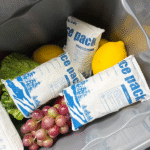Cold chain asset monitoring is essential for businesses dealing with temperature-sensitive goods. Whether you’re managing pharmaceuticals, alimento, o productos biotecnológicos, ensuring these items remain within required temperature ranges is critical. En 2025, effective monitoring systems reduce spoilage risks, improve compliance, and optimize cold chain operations. Let’s explore the key technologies and strategies that make cold chain asset monitoring indispensable for modern logistics.
-
What is cold chain asset monitoring and why is it crucial for 2025?
-
How does asset monitoring improve operational efficiency and reduce costs?
-
What are the latest technologies shaping cold chain asset monitoring?
-
How can asset monitoring help in regulatory compliance?
-
What trends should you watch in cold chain asset monitoring for 2025?
What Is Cold Chain Asset Monitoring, and Why Does It Matter in 2025?
Cold chain asset monitoring involves tracking and managing the condition of temperature-sensitive goods throughout the entire supply chain. This includes monitoring refrigerated containers, transport vehicles, and real-time data from IoT sensors. With increasingly stringent regulations, especially in sectors like pharmaceuticals and food, cold chain asset monitoring helps ensure product integrity, seguridad, y cumplimiento.
Key Benefits of Cold Chain Asset Monitoring:
-
Previene el deterioro: Continuous tracking ensures products remain within the safe temperature range, preserving their quality.
-
Enhances Compliance: Helps meet regulatory standards by providing verifiable temperature data.
-
Reduces Operational Costs: By catching issues early, businesses can avoid costly product loss and spoilage.
How Does Cold Chain Asset Monitoring Improve Operational Efficiency?
Cold chain monitoring systems provide real-time visibility into temperature, humedad, and other conditions, enabling businesses to act before problems arise.
-
Real-Time Data for Better Decision Making: Access to live data ensures immediate corrective actions if a temperature fluctuation occurs, prevenir el deterioro.
-
Improved Asset Utilization: Continuous monitoring allows businesses to identify maintenance needs early, ensuring equipment is used effectively and reducing downtime.
Key Metrics for Cold Chain Asset Monitoring
Tracking essential metrics is crucial to optimizing cold chain operations:
| Métrico | Descripción | Importance for Operations |
|---|---|---|
| Temperatura | Tracks temperature fluctuations | Garantiza la seguridad del producto |
| Humidity | Monitors moisture levels | Protects sensitive products |
| Shock/Vibration | Monitors external disturbances | Maintains product integrity |
| Battery Level | Monitors sensor power levels | Prevents sensor failure |
| Ubicación | GPS tracking of assets | Ensures timely deliveries |
Key Technologies Transforming Cold Chain Asset Monitoring in 2025
En 2025, cold chain asset monitoring is evolving with the integration of cutting-edge technologies like IoT, cadena de bloques, Y tu tienes, providing new capabilities for more efficient and secure operations.
Internet de las cosas (IoT) Sensores
IoT sensors are revolutionizing cold chain monitoring by providing real-time data on temperature, humedad, y más. These sensors send alerts if conditions fall outside predefined parameters, allowing for immediate corrective action.
Blockchain for Transparency and Trust
Blockchain technology records every step of the shipment process, creating a secure and transparent trail of data. This is particularly valuable in industries like pharmaceuticals, where maintaining temperature control is critical.
Inteligencia artificial (AI) and Machine Learning
AI uses historical data to predict potential issues before they occur. By analyzing patterns, AI systems can forecast when temperature deviations or equipment failures are likely, allowing companies to address these issues proactively.
Cloud-Based Monitoring Systems
Cloud-based systems integrate data from various assets, allowing businesses to manage cold chains globally. Real-time access to this data enables faster decision-making and enhanced operational efficiency.
Cold Chain Asset Monitoring Best Practices for 2025
1. Integrate IoT Sensors for Real-Time Monitoring
Implementing IoT sensors that provide continuous data on asset conditions allows businesses to respond to issues immediately, reducing risks of product loss.
2. Regular Software and Hardware Updates
As technologies evolve, so should your monitoring systems. Regular updates will ensure that you’re benefiting from the latest features and security improvements.
3. Implement Preventive Maintenance
Continuous monitoring helps identify maintenance needs before equipment failure, ensuring uninterrupted operations and preventing costly breakdowns.
4. Use Data Analytics for Continuous Improvement
Leverage data collected through monitoring systems to analyze trends, identify inefficiencies, and uncover opportunities for cost savings.
2025 Trends in Cold Chain Asset Monitoring
Tecnologías emergentes
-
AI and IoT Integration: More companies are using AI-powered systems for predictive maintenance and route optimization.
-
Blockchain for Trust: Blockchain is becoming integral for ensuring traceability and transparency in cold chain operations.
Sustainability and Efficiency
New technologies focus on reducing the carbon footprint of cold chain logistics. Solar-powered refrigerated containers and energy-efficient cooling systems are gaining traction in 2025.
End-to-End Monitoring
From manufacturing to last-mile delivery, businesses are extending their cold chain monitoring systems to track assets all the way to their final destination, ensuring product integrity at every stage.
Preguntas frecuentes
What is the role of cold chain asset monitoring in pharmaceuticals?
Cold chain monitoring ensures pharmaceuticals, como vacunas y productos biológicos, stay within the required temperature range, maintaining their efficacy and patient safety.
How does cold chain monitoring reduce costs?
By providing real-time alerts, businesses can address issues early, reduciendo el desperdicio, avoiding penalties for non-compliance, and lowering overall operational costs.
Conclusión y recomendaciones
En 2025, adopting advanced cold chain asset monitoring systems is crucial for improving efficiency, cumplimiento, and product safety. Technologies like IoT, AI, and blockchain offer new opportunities for businesses to enhance their operations.
Siguientes pasos:
-
Evaluate current monitoring systems and identify areas for improvement.
-
Invest in IoT sensors and cloud-based systems for real-time tracking.
-
Leverage AI and blockchain to enhance predictive capabilities and transparency.
-
Train staff on the latest technologies and best practices to optimize operations.
Acerca de Tempk
Tempk is a leader in developing cold chain monitoring solutions, offering advanced IoT sensors, AI analytics, and blockchain technologies. Our solutions help businesses ensure the safety and integrity of temperature-sensitive products throughout the supply chain.
Tomar medidas: Contact Tempk for a personalized consultation to optimize your cold chain asset monitoring systems.
























